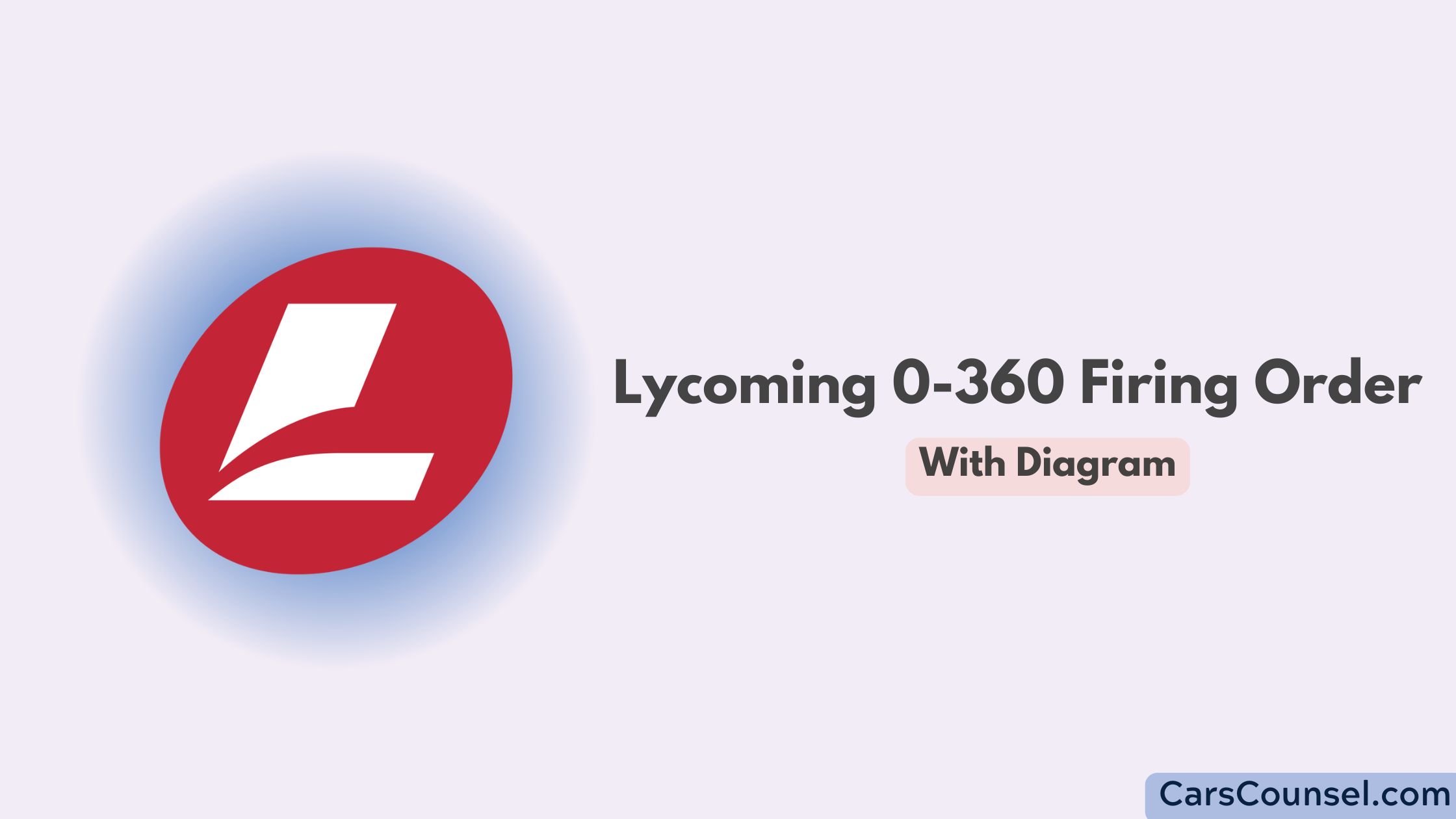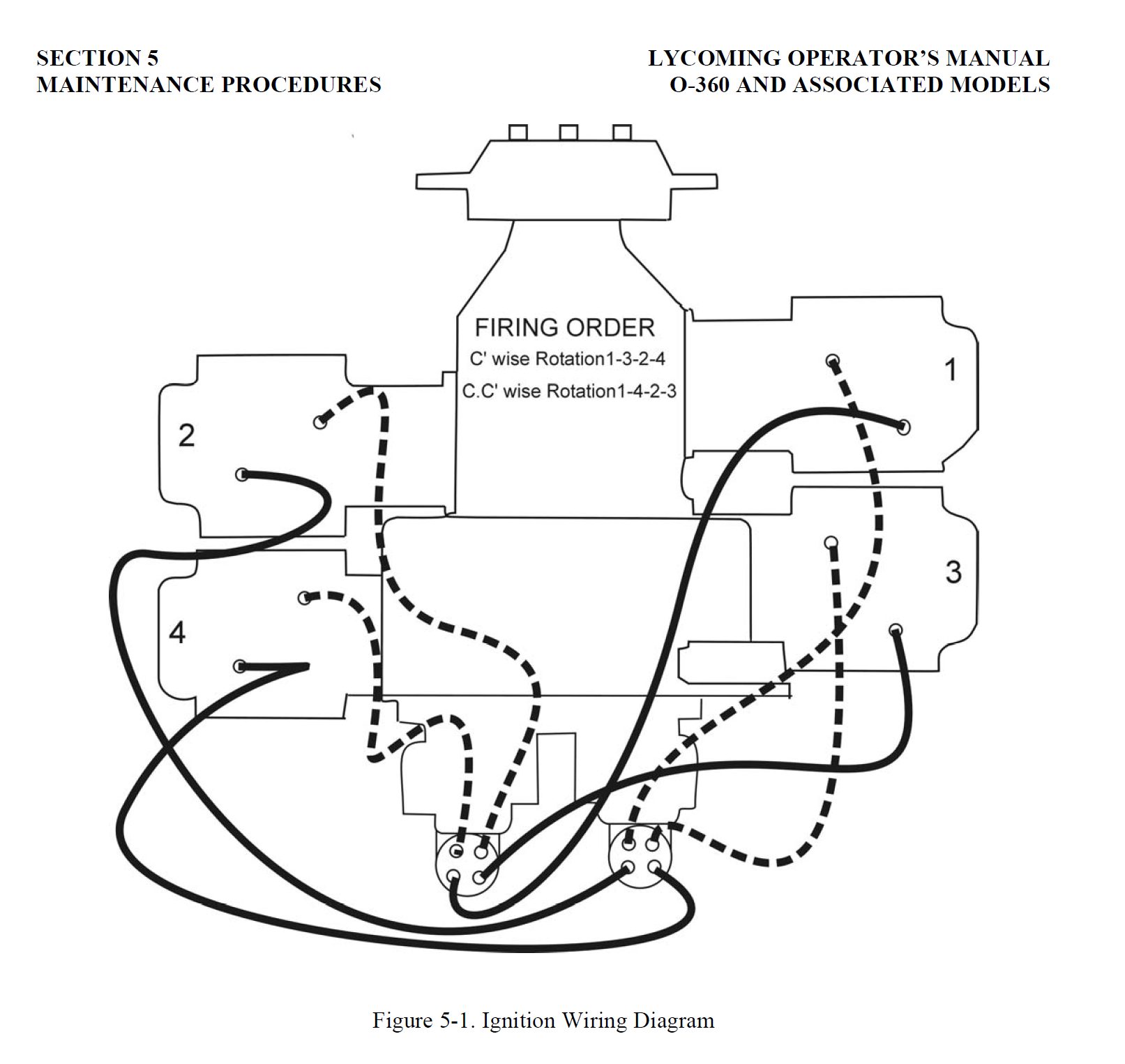The Lycoming O-360 is a four-cylinder, horizontally opposed, air-cooled aircraft engine, well-regarded for its reliability and performance.
The Lycoming O-360 delivers dependable power in a variety of general aviation aircraft, including the Cessna 172, Piper Cherokee, and others. The firing order is a critical aspect of its operation, ensuring smooth combustion and balanced performance.
In this article, we’ll explore the firing order of the Lycoming O-360 engine, its significance, and how it contributes to its overall functionality. Whether you’re a pilot, mechanic, or aviation enthusiast, this guide provides clear, essential insights.

Quick Navigation
The Lycoming O-360 Firing Order
The firing order for the Lycoming O-360 engine is: 1-3-2-4

How the Firing Order Works
- Cylinder 1 Fires First: The frontmost cylinder on the right bank initiates the cycle.
- Cylinder 3 Fires Next: The rear cylinder on the right bank fires second.
- Cylinder 2 Fires Third: The front cylinder on the left bank ignites next.
- Cylinder 4 Fires Last: The sequence ends with the rear cylinder on the left bank, completing the cycle.
This firing order alternates between the engine’s left and right banks, ensuring balanced operation and even power delivery.
Why Lycoming Uses the 1-3-2-4 Firing Order
The 1-3-2-4 firing order is optimized for the O-360’s horizontally opposed configuration. Here’s why:
- Balanced Operation: Alternating ignition events between opposing banks reduces vibration and ensures smooth performance.
- Efficient Combustion: The sequence provides optimal timing for the intake and exhaust strokes, maximizing combustion efficiency.
- Continuous Power Delivery: Ensures that one cylinder is always in its power stroke, maintaining steady power output.
- Durability: Reduces stress on the crankshaft and other internal components, extending engine life.
What Is a Firing Order?
The firing order is the specific sequence in which the engine’s spark plugs ignite the air-fuel mixture in each cylinder. This sequence is crucial for producing the power necessary to propel the aircraft efficiently and reliably.
The firing order is determined by the engine’s design to balance mechanical forces, reduce vibrations, and maximize efficiency.
Why Is the Firing Order Important?
- Smooth Operation: Ensures the engine runs evenly and minimizes vibrations.
- Performance: Balanced ignition timing delivers consistent power output.
- Efficiency: Proper firing sequence optimizes combustion, improving fuel efficiency.
- Durability: Reduces wear and tear on the crankshaft and other internal components.
Overview of the Lycoming O-360 Engine
The Lycoming O-360 is part of the Lycoming 360 family of engines. It is a four-cylinder, horizontally opposed, air-cooled engine with a displacement of 360 cubic inches. Its robust design and simplicity make it a staple in general aviation.
Key Features of the O-360
- Horizontally Opposed Layout: Two cylinders on each side of the engine, arranged in opposition to one another.
- Air-Cooled: Utilizes airflow to regulate engine temperature.
- Four-Stroke Cycle: Operates on the intake, compression, power, and exhaust strokes.
- Cylinder Numbering:
- Right Bank: Cylinders 1 and 3 (front to back).
- Left Bank: Cylinders 2 and 4 (front to back).
Identifying the Firing Order
Knowing how to verify and understand the firing order is essential for maintenance, troubleshooting, and engine tuning. Here’s how to identify it:
Consult the Engine Manual
The engine manual provides detailed specifications, including the firing order and cylinder numbering.
Locate Cylinder Markings
Cylinder numbers are often stamped on the engine block or visible near the spark plugs, making identification straightforward.
Use Timing Marks
The crankshaft or magneto timing marks can help confirm the firing order during maintenance or repairs.
Symptoms of Incorrect Firing Order
An incorrect firing order can cause significant performance issues in the Lycoming O-360 engine. Here are the most common symptoms:
Performance Issues
- Engine Misfires: Misaligned ignition disrupts combustion, leading to uneven power output.
- Rough Running: The engine vibrates excessively or feels unstable during operation.
- Power Loss: A disrupted firing order reduces overall power output, affecting performance.
- Increased Fuel Consumption: Inefficient combustion results in higher fuel usage and emissions.
- Excessive Heat: Misfiring cylinders can overheat, risking damage to the engine.
Causes of Incorrect Firing Order
- Misconnected Ignition Wires: Spark plug wires routed to the wrong cylinders disrupt the sequence.
- Faulty Magneto Timing: Improperly timed magnetos can affect the firing sequence.
- Damaged Components: Worn or faulty spark plugs, magnetos, or ignition leads may interfere with proper timing.
Diagnosing and Fixing Firing Order Problems
If you suspect issues with the firing order in your Lycoming O-360 engine, follow these steps to diagnose and resolve them:
Diagnostic Steps
- Inspect Spark Plug Wires: Ensure each wire is connected to the correct cylinder based on the 1-3-2-4 sequence.
- Check Magneto Timing: Verify that the magnetos are correctly timed to the crankshaft.
- Perform a Compression Test: Check for adequate compression in all cylinders to ensure proper combustion.
- Use a Timing Light: Confirm ignition timing with a timing light and compare it to the manufacturer’s specifications.
Fixing Common Issues
- Reconnect Ignition Wires: Correctly route spark plug wires to the appropriate cylinders.
- Adjust Magneto Timing: Align the magnetos with the correct crankshaft timing marks.
- Replace Faulty Components: Install new spark plugs, ignition leads, or magnetos if necessary.
Preventative Maintenance for Firing Order Reliability
Maintaining the proper firing order is essential for ensuring the smooth and reliable operation of the Lycoming O-360 engine. Follow these preventative measures:
Regular Inspections
- Check the condition of spark plugs, ignition leads, and magnetos during routine maintenance.
- Look for signs of wear, corrosion, or loose connections.
Replace Components as Needed
- Replace spark plugs and ignition wires at intervals as Lycoming recommends.
- Use high-quality OEM components to ensure compatibility and reliability.
Verify Magneto Timing
- Periodically inspect and adjust magneto timing to match the manufacturer’s specifications.
- Perform timing checks whenever the engine undergoes significant maintenance.
Engines with Similar Firing Orders
FAQs About the Lycoming O-360 Firing Order
Can the Firing Order Be Changed?
No, the firing order is fixed by the engine’s design and crankshaft configuration. Altering it would require extensive modifications.
What Happens If the Firing Order Is Incorrect?
An incorrect firing order can cause misfires, rough running, power loss, and potential damage to internal components.
How Can I Verify the Firing Order?
Refer to the engine manual, inspect cylinder markings, and use timing tools to confirm the ignition sequence.
Is the Firing Order the Same for All Lycoming Engines?
No, while many Lycoming engines share similar firing orders, variations may exist based on the model and configuration.
Conclusion
The 1-3-2-4 firing order is a fundamental aspect of the Lycoming O-360 engine’s design, ensuring smooth operation, balanced power delivery, and efficient combustion. Understanding this sequence is essential for maintaining and troubleshooting the engine, as well as ensuring safe and reliable flight performance.
By following preventative maintenance practices and addressing issues promptly, you can ensure that your Lycoming O-360 engine continues to deliver the dependable performance it’s known for in general aviation. Whether you’re a pilot, mechanic, or enthusiast, understanding the firing order is a key step in mastering this trusted engine.

